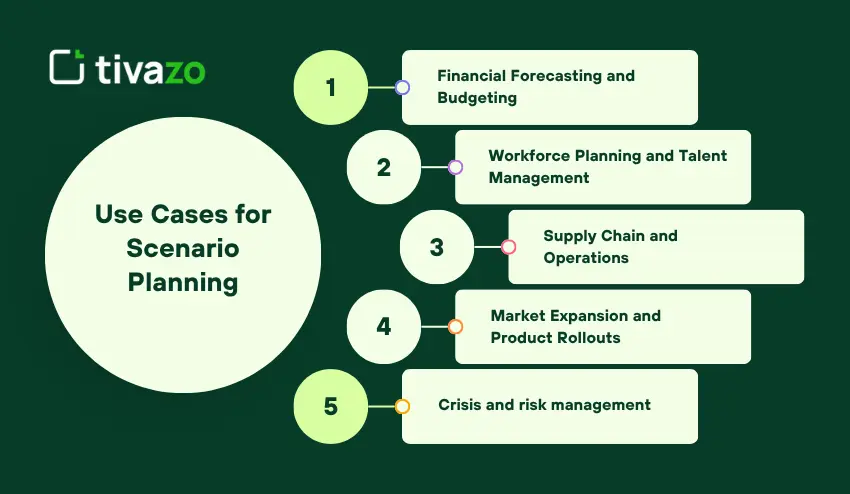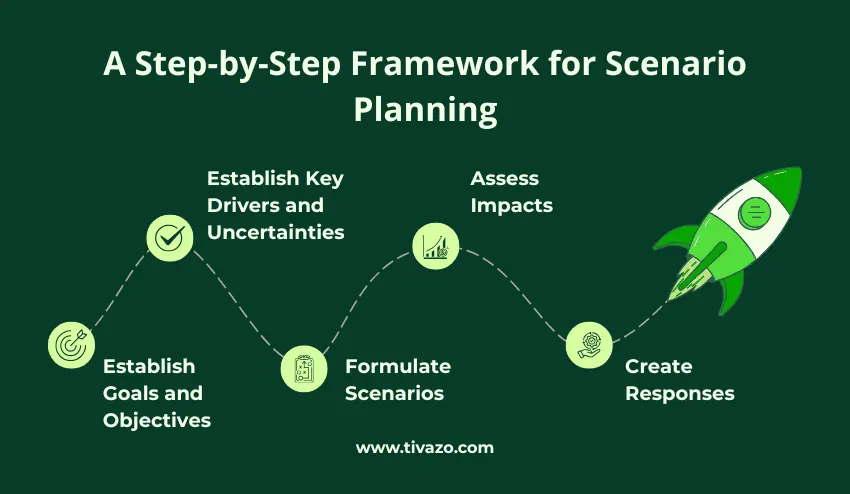The contemporary workplace comes with many uncertainties, fluctuating market demands, unpredictable global occurrences, and rapidly changing technology. No organization, no matter its dimension or specialization, should depend exclusively on fixed plans or assumptions. This is where scenario planning comes in.
It is a structured process that creates thought exercises for organizations to consider different futures and inform strategies for each. Rather than try to guess what happens next, businesses engaged in scenario planning experiment with several “what-if” types of situations, such as steep drops in revenue, unforeseen supply chain troubles, or upticks in demand, and determine how they would respond and stay proactive.
For business and teamwork, it is not an effort to predict the future; it is a way to ensure you are prepared for the future. Scenario planning provides leaders with more enhanced decisions faster while uncertainty persists. In this guide, we will discuss what scenario planning is, its usefulness, the framework to develop your own, real-life use cases, missteps to avoid, and how Tivazo can bring data-driven planning into your world.
What is Scenario Planning?
Essentially, scenario planning is the act of generating and analyzing multiple future conditions to support better decision-making today.
In a workplace context, it is a proactive process in which teams create, model, and test multiple variations of the future, from best-case growth scenarios to worst-case downturns. Instead of responding when an unforeseen event occurs, your organization already knows the course of action that will be taken.
For example:
Let’s say your sales team finds a deceleration in quarterly revenue. Through planning, they have already devised the models for low-revenue environments, and these models include action plans related to budget cuts, cross-training, and lead nurturing initiatives. So, when you see a drop in your numbers, the plan is already in motion, and you minimize loss and stress.
Scenario planning links closely to strategic planning and business continuity; it allows the organization to obtain foresight and then connect that foresight to concrete action.
The Importance of Scenario Planning in Business
The only constant in today’s fast-changing business environment is uncertainty. Companies that respond once a problem emerges are typically too late to act, wasting resources and seizing opportunities. Scenario planning pushes managers and decision-makers to adopt a proactive way of thinking, planning contingency options for many futures not a single point forecast.
Benefits of Scenario Planning
- Agility: Organizations can adjust strategy to immediate market conditions quickly to reduce downtime and disruption.
- Proactive Thinking: Teams anticipate disruptions and opportunities rather than react to panic under duress.
- Smart Decision Making: When a future cannot be predicted, at least laying out multiple contingencies creates a decision-making process to compare and contrast multiple options for future outcomes, and allows the organization to pick the next best choice.
A Case Comparison:
Let’s provide a conditional Case Study of two mid-sized companies that faced a sudden supply chain disruption. Company A had done scenario planning; they activated backup suppliers and presented redeveloped delivery schedules without client disruption and continued to satisfy the client. Company B had not done scenario planning; their team scrambled for a solution, which took time to reorganise delivery schedules and lost the confidence of the client with delays as well as revenue. Company A did not experience luck; they were prepared.
By creating and embedding planning for scenarios into their workplace culture, managers have developed a forward-looking organization that survives change through resilience.
Types and Variations of Scenario Planning
Businesses do not face the future from only one vantage point. The way organizations will prepare for uncertainty is influenced by goals, the availability of data, and how much risk is involved. Knowing this spectrum of approaches allows managers and decision-makers to pick the approaches that are best suited for their organization.
Quantitative vs. Qualitative Approaches
- Quantitative Approaches: These approaches put lived experience and value in numerical data, metrics, or statistical models to project expected outcomes. This is particularly useful if decisions can be tied to a measurable factor, such as sales or costs, or production capacity. For example, a finance team hi might use existing sales data to create a revenue model assuming it faced several different market conditions; modeling projected revenue for a) a 10% increase in unit demand, b) a 5% increase cost per unit, or c) a 10% increase in overall fixed expenses.
- Qualitative Approaches: These approaches put lived experience and value in stories, expert stories, and trends rather than “hard” numbers. Qualitative approaches are valuable if we expect uncertainty and complexity to predict customer behavior or if technology will change possibilities or regulations governing behavior in uncertain situations. For example, a marketing team might create story-based scenarios to explain how a new competitor could emerge in its market, assessing how a target audience might react with innovative ways to differentiate from or collaborate with the new competition.
It is easy to see the value in combining methods to create a balanced view; quantitative modeling can provide measurable input, while the qualitative models can contextualize thinking and innovation with flexible thinking.
Strategic, Operational, Normative, and Event-Driven Types
| Type | Description | Best For | Example |
|---|---|---|---|
| Strategic | Focuses on long-term planning and major business directions | Executives, senior managers | A company explores how expanding into international markets might affect revenue, staffing, and supply chain requirements over the next 5 years |
| Operational | Concentrates on day-to-day processes, workflow, and resource allocation | Department heads, team leads | Adjusting workforce schedules and production capacity to handle seasonal spikes in demand |
| Normative | Centers on desired or ideal outcomes, setting a target future to guide decisions | Leadership teams | Mapping out actions required to achieve a 20% market share growth while maintaining profitability |
| Event-Driven | Prepares for specific triggers or crises, often sudden or unexpected | Risk managers, continuity planners | Planning responses for sudden supply chain disruptions, cybersecurity incidents, or regulatory changes |
Choosing the Right Approach
The option chosen should mirror the uncertainty presented and the organization’s ability to respond. For instance: Nothing Stops a Business Selling a Product – Incentives for other businesses to hire might do something, but time to market is reflected in buying decisions.
- A retail organization with predictable and seasonal demand may use quantitative, operational approaches to optimize staffing and inventory.
- A new technology firm entering an uncertain market may use qualitative, strategic approaches to determine competitive moves and shifts in consumer behavior.
- In many cases, large organizations are competent in holding multiple scenarios simultaneously. Something could be done to a long-standing strategy while keeping the short-term operations resilient.
Use Cases for Scenario Planning
Scenario planning can be more than just a conceptual idea, as it has been used successfully in many aspects of a business. Using scenario planning, managers and teams can preemptively address challenges, plan resource allocation, and make decisions when conditions are not necessarily urgent. Below are examples of various workplace and office use cases and relevant examples.

1. Financial Forecasting and Budgeting
Revenue streams may not be constant, cost ratios may change, and the market may shift overnight. Since these challenges are complex, the teams must use scenario planning to surface risks and opportunities and think through the different financial scenarios.
Example: A retail store thinks its quarterly business may decrease by 15 percent because of seasonality. The finance team can then consider scenarios to reduce expenses, reallocate marketing budgets, or adjust pricing to create contingency plans that ensure cash flow and profit.
2. Workforce Planning and Talent Management
Staffing and productivity are central to all business operations. People matter! Scenario planning can help an HR team or management team preplan staff needs, skill gaps, and attrition gaps
Example: An IT company has a high potential product launch. The IT department uses scenario planning to anticipate possible workloads and skill sets needed to support high adoption, medium, or low levels. HR would then be able to forecast hiring needs, training dates, and plan for temporary support to ensure immediate and product needs are met by the customer.
3. Supply Chain and Operations
Disruptions in operations can have seriously adverse effects on the delivery of service levels and the availability of product/service. Preparing for operational outcomes will help reduce downtime and inefficiency.
Example: A manufacturing company creates an operational model for a scenario in which a key supplier does not deliver on time. The operational team devised alternative sourcing plans and forgone production schedules, thereby reducing any delays that might have occurred.
4. Market Expansion and Product Rollouts
When rolling out a new product or entering a new market, there is a considerable sense of risk. Scenario planning gives teams the chance to identify potential resistance and make plans to address these issues before they arise.
For example, a software firm can model three scenarios regarding entry to an international market: strong adoption, moderate adoption, and low adoption. Each of these scenarios would have planned marketing spend, hiring local staff, and support needs. This approach gives the launch additional flexibility while still being build on actual data.
5. Crisis and risk management
Unanticipated crises, regulatory changes, cyberattacks, and natural disasters require immediate action and response. Advance planning and scenario modelling prepare the organization to do just that.
For example, a logistics company can model potential outcomes of severe weather on transport routes. In these scenarios, early planning can define responses (alternate routes or temporary warehousing) so that customers continue to receive their goods with minimal disruption.
Scenario planning in each of these areas gives the organization better options and options, whilst reducing risk and uncertainty.
A Step-by-Step Framework for Scenario Planning
To use scenario planning successfully, you will need a wide-ranging approach. Utilizing a framework facilitates leaders in making sure their teams engage in on-point futures, ambiguity, and informed decision-making. Presenting a six-step process means this can be applied in practically any office or business setting.

1. Establish Goals and Objectives
Begin by defining what you hope to achieve. You could be preparing for revenue turmoil, labor changes, supply chain changes, and market expansions and/or fluctuations. Well defined objectives keep the scenario exercise on track and relevant.
For example, the marketing department wants to be prepared for the launch of a product even if delivery of creative assets has been delayed. The goal is to explore possible delays to get ahead of the end deliverable and set-up possible contingencies.
2. Establish Key Drivers and Uncertainties
Identify the main drivers that will most impact outputs. The drivers can be internal (capacity of staff, access to software) or external (market demand, government regulation, economic indicators).
For example, a logistics company has three main uncertainties, which are the price of fuel fluctuating, extreme weather events, and port strikes.
3. Formulate Scenarios
Craft several credible future states that fuse uncertainty with plausible drivers. Generally, you can use 3–5 scenarios to articulate possible outcomes without overcomplicating the task.
For Example: A software firm may create scenarios for high, moderate, and low adoption for a new software product, each having its own operational plan.
4. Assess Impacts
The next step is to examine the impacts of each of the scenarios on their business objectives. This is where you assess the risk, resources needed, and analyze bottlenecks.
For Example: For a manufacturing company, in a scenario that a critical supply is no longer a viable supplier, the company would need to evaluate the best alternative suppliers and plan for delivery and cost implications.
5. Create Responses
Once you have identified and assessed impacts of the scenarios on planned objectives, you will want to build actions and strategies in order to create an organization that responds to changes. This can include contingency measures and alternative use of resources.
For Example: HR is prepared for the increase in hiring, if demand suddenly increases when they engage some temporary staffing contracts.
5. Track and Revise
If there is one thing you take away from scenario planning, it is that it is not a one-time or a completely linear exercise. Be diligent in tracking key signals from your indicators, revisiting scenarios, and when relevant, update your assumptions based on new information that may be presented to you.
For Example: A retail chain is tracking sales patterns and consumer habits to update their seasonal demand scenario assumption.
Common Mistakes and How to prevent them.
Scenario planning is something that can be wrong even in highly experienced managers. The following are the errors that undermine the process – and how to rectify them.
- Making the Process a Complicated Issue.
Teams tend to construct too many situations or analyse details. This slows down the decision making process and creates confusion.
Fix: Keep it focused. There are three or five clear scenarios that should be sufficient to take into account the most possible futures. - Ignoring Data Signals
Other plans are too opinion-based and not fact-based. The results lack evidence and cannot be credible.
Fix: Make your assumptions based on real numbers, such as historical sales, performance reports, or customer feedback. - Excluding Key Teams
When planning remains in the hands of the leadership, it lacks the input of the people managing day to day activities.
Remedy: Engage finance, HR, operations managers. Every department has something that makes the scenarios more realistic. - Addressing It as a One-Time Project.
One workshop will not make a business future-proof. The situation in the market, technology, and customer behavior evolves too frequently.
Fix: Review your situations every three months or when business changes significantly. Your plans are kept up to date. - No Link to Action
In some cases, planning stops at the what if point and nothing is followed up.
Fix: Make every situation a detailed plan – assign ownership, establish triggers, and write down specific responses.
Scenario planning would be part of team thinking rather than an annual activity when correctly implemented. It makes businesses remain prepared, malleable, and assured even when the future is unpredictable.
How Tivazo Facilitates Scenario Planning
Tivazo empowers organizations to make scenario planning a continuous, data-driven exercise. Rather than relying on static reports or manual forecasting, Teams can leverage Tivazo’s real-time analytics to provide visibility into how different decisions or external changes may or will impact business outcomes. This side-by-side comparison and visual understanding of possibilities will help teams make the most informed choices in the future.
With Tivazo, organizations can pull from multiple data sources: sales, marketing, customer behavior, and operations, into one platform. This one-stop-shop provides a single view of performance and helps identify trends and patterns that may not be visible when working in separate tools. Consequently, organizations may see early change, and modify and adapt strategies before risks or opportunities turn sour.
Also, Tivazo promotes collaboration between teams. Given that insights are easy to access and digest, Tivazo allows leaders and department leads to collaborate on scenario construction based on one source of data, providing alignment and efficiency in the decision-making process. Equally, every scenario learned through the application of Tivazo includes not just strategic goals, but on-the-ground realities of any plan or option.
Conclusion
Scenario planning is not just a strategic exercise; it is a practical strategy that allows businesses to anticipate challenges, assess and make decisions, or be responsive under uncertainty. Scenario planning enables, with an exploration of scenarios of multiple future possibilities, managers to surface risk and identify possible resource reallocation for planning teams engaged with future activities.
In workplaces and offices, scenario planning builds resilience, supports decision-making, and ensures the operations continue if something unexpected occurs. Scenario planning becomes actionable when it is utilized alongside tools such as Tivazo, just-in-time scenario planning, and provides information for tracking for less it easier for managers or a team to turn plans into action.
In fact, investing the time in scenario planning today will readily inform your organization for tomorrow. In fact, organizations, while always, should be monitoring for the next possibilities to adapt according to changes.




